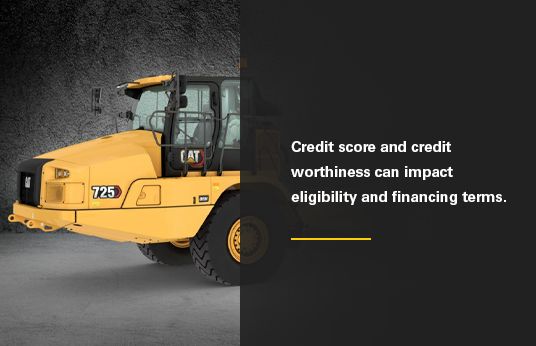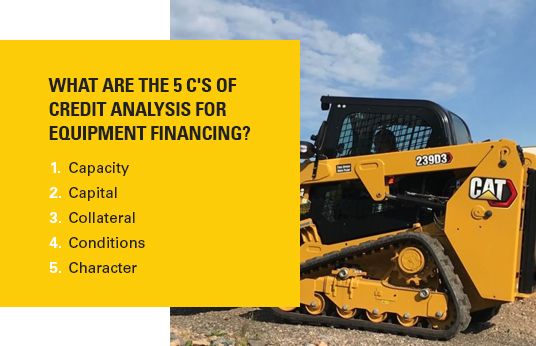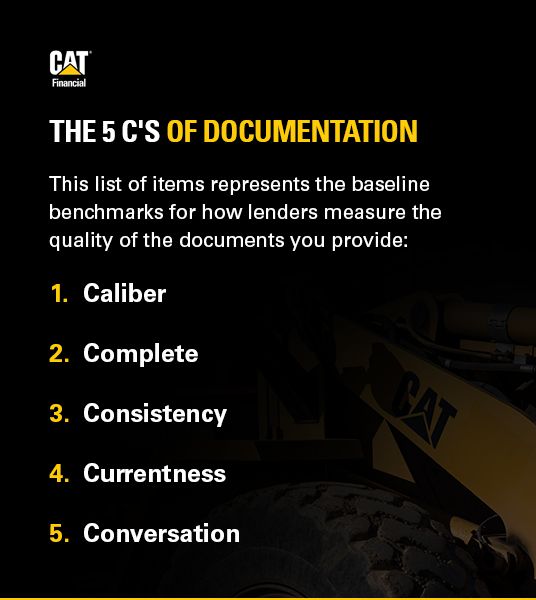

Sign In
Welcome! Sign In to personalize your Cat.com experience
If you already have an existing account with another Cat App, you can use the same account to sign in here
Register Now
One Account. All of Cat.
Your Caterpillar account is the single account you use to log in to select services and applications we offer. Shop for parts and machines online, manage your fleet, go mobile, and more.
Account Information
Site Settings
Security
What Equipment Financing Lenders Look For: The C’s of Credit
Estimated read time: 5 minutes
When you begin searching for business credit or financing options to acquire heavy equipment, it's important to know what a lender will consider to determine your credit worthiness before you apply. Financing heavy machinery can help facilitate growth for your business, which means it's critical that you understand the factors a lender will use to approve a equipment financing application.
We're breaking down the 5 C's of credit and 5 C's of documentation to prepare your business for the equipment financing application process.
What Equipment Financing Lenders Look For: The C’s of Credit
Explore the factors that lenders use to review credit worthiness:
Credit History
Lenders will review your business's credit score and report to evaluate the risk associated with providing you with capital. Your credit score helps determine your likelihood of paying back borrowed money and can impact your eligibility and your interest rate.
Lenders may also review the following items to learn more about your credit worthiness:
- Foreclosures
- Bankruptcy
- Outstanding debt
- Delinquent accounts
Income and Expenses
If your business has a steady income, lenders are less likely to identify you as a risk. In other words, they want to know you have the funds available to repay your debts on time.
Consider your business's expenses and your debt-to-income ratio. Be sure you can make your payments in full of your existing operating costs.
Loan Terms
The equipment loan term is important to lenders as the length of the loan determines how quickly you'll completely settle your debt by making regular payments. Cat Financial typically offers 24,36, 48, and 60-month equipment loans to qualified customers.
Generally, the shorter your loan term is, the higher your payment will be. However, you will usually pay less interest with shorter teams, and you can repay your debt sooner.
The percentage included with equipment loan indicates the amount of interest added to the total equipment price. In other words, lenders typically charge a fee in exchange for the borrowed capital. Sometimes, special promotions are available that offer 0% financing for a specific period of time.
Down Payments
Equipment financing lenders also want to know how much you can afford to put down. In some cases, down payments are required. By paying a lump sum upfront, you can usually appear as less of a risk. It's recommended to contact your local Cat® dealer to learn more about your equipment financing options and requirements.
Collateral and Liquid Assets
When it comes to extending credit, lenders expect to receive all of their money back. Collateral and liquid assets can also offer a sense of protection in case your business is unable to repay debts. Collateral is something of value you own that the bank can seize if you're not able to complete your contractual payment obligation. We'll discuss collateral in depth later.
Liquid assets refer to items that can convert into cash if needed, such as:
- Stocks
- Government bonds
- Savings

What Are the 5 C's of Credit Analysis for Equipment Financing?
If you need equipment financing, there are several factors that lenders evaluate during the equipment financing application process. Credit worthiness criteria can be categorized into two verticals — the 5 C's of credit analysis and the 5 C's of documentation.
These are five of the factors equipment financing lenders typically use to evaluate the risk associated with lending you money.
1. Capacity
Capacity refers to your ability to afford monthly payments and repay loans on time.
The lender will determine if you can make payments when they are due using the debt-to-income (DTI ratio), which is represented with a percentage.
Follow the steps below to calculate your business's DTI ratio:
- Add up your monthly debt payments
- Divide your monthly debt payment by your monthly income before taxes
- Multiply that number by 100
Lower DTI ratios typically indicate lower monetary risks and lenders can use this number to signify whether or not your business can take on more debt.
Before getting started, have a plan for how you'll make the monthly payments. Consider the following:
- Cash flow
- Payment history
- Current market share
For Cat Financial, we also want to know if the equipment your interested is in acquiring is replacing an existing unit or if you’re planning to expand your equipment fleet.
2. Capital
Your business's capital encompasses all financials that can be utilize to repay your loan, including:
- Balance Sheet
- Net Worth
- Capitalization
Put simply, Assets – Debts = Net Worth or Capital.
How much money do you already have invested in the business? Your company's debt-to-equity ratio — your company's liabilities divided by shareholder equity — will be a determining factor in whether or not your business has enough equity to shoulder more debt.
Capital represents the avenues you can take to make payments on your loan if something were to happen to your business like losing a critical client or other major financial setbacks. Capital is similar to a down payment as it can show you are a capable and serious candidate for financing options or business credit.
Ultimately, your capital provides lenders with peace of mind, thanks to the added security it offers.
3. Collateral
Collateral refers to something you can offer as security for a line of credit or loan. If you are unable to make your payments, the lender can take your collateral as a means of repaying your debts.
The lender will evaluate the asset you are offering. If you secure other debt with that same item, remember you will have to subtract that value.
Banks and other institutions that extend credit offer secured and unsecured options. Secured loans or lines of credit indicate that the recipient has to offer collateral. This trade is considered to be less risky for lenders. If you do not pay back your debts, these items are at risk and you may forfeit them.
What additional monetary or capital-based guarantees can you put forward? Although many lenders require collateral for obtaining business financing, obtaining leasing equipment or a commercial line of credit often does not involve this factor.
4. CONDITIONS
Conditions are the fourth C of credit. They refer to the information that the lender will use to determine if you qualify for financing options or business credit. For Cat Financial, a transaction can be “Approved as Submitted” or “Approved with Conditions.” Approved with Conditions means that a deal was approved with mitigants, such as Personal or Corporate Guarantee, Additional or Cross Collateral, Cash Down or Trade-in.
Conditions can include external factors that are not in your control, such as:
- Federal interest rates
- Current industry trends
- Economic standings
- Competition
They will also take a look at your business's history to evaluate if you are a desirable candidate. When you are looking for a line of credit or financing options, be sure to clearly share how you plan to utilize the funds for your company.
What will the financing be used for? You should have a business-related usage for the financing, such as working capital, new office space or investing in new equipment.
Having a clear and established plan is a major key to securing a loan for your business. You must be able to demonstrate how your company will be successful based on various conditions.

5. CHARACTER
Character encompasses your business's credit history. The lender will look into how you've managed your past debts.
Different lenders have various criteria for analyzing your credit scores and reports. They want to see how much money you've borrowed in the past and your payment history details.
A record of the following could negatively impact your business's ability to get a loan or line of credit:
- Bankruptcies
- Late payments
- Foreclosures
What kind of general impression do you make on the lender? Although this component can be tough to quantify, business experience, educational background and personal credit score all serve as factors that help lenders make an informed decision.
You will also need to provide the proper documents during the credit analysis process. Lenders will review your firm's financial history to determine your company's financial strength and ability to repay any credit that has been extended.
Some lenders establish minimum credit score requirements. The higher your business's score, the lower the associated risks of loaning you money or equipment.
If you need to repair your business credit score, consider doing the following:
- Pay bills on time or early
- Establish repayment agreements
- Lower your credit utilization ratio
- Actively dispute any errors in your credit report
The 5 C's of Documentation
This list of items represents the baseline benchmarks for how lenders measure the quality of the documents you provide:
1. Caliber
What type of documents are you able to provide to the lender? High-caliber documentation includes tax returns and third-party audits in addition to company-prepared forms and compilations. Providing the lender solely with internal bookkeeping documents typically isn't enough.
2. Complete
Have you given all of the right documents? The more robust and complete your firm's documentation history, the better, so don't forget to include any documents that could be important in the decision-making process, including all debt schedules and forms.
3. Consistency
Does your business provide the same set of documents every year? Having records from every other year isn't enough, nor is only having a portion of the available documents for a given filing.
4. Currentness
How recent is the information you provided? Outdated information won't illustrate your company's present-day financial situation and will only create a delay in the process, as the lender will request you provide it.
5. Conversation
Are you able to give the lender any needed explanations? A chat with the person reviewing your application can bridge the gap between any missing information and supplement your credit application.

Additional Articles
Find in-depth articles to answer your questions about construction equipment financing, and expert tips to help you navigate today's economy as a successful business.






